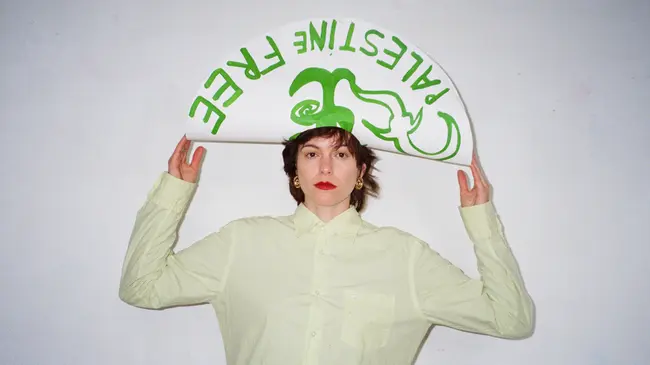I learned to play by hitting the bass with objects

Farida Amadou’s first foray into installation art is an interactive audiovisual sculpture that reflects her practice since 2011 as an experimental bassist moving between noise and free jazz. Her sculpture’s steely industrial tactility and the unpredictability of what will emerge illuminate Amadou’s own improv-heavy process of making music. Beckoning the audience to pluck at its strings and work with the reverberations they produce, the installation, on view during EUROPALIA TRAINS & TRACKS, stays true to her conviction that anyone can play an instrument.
Can you talk me through your installation In-Between?
It comes in two parts. For the visual part, I filmed images on the train between Brussels, Mechelen, Ostend and Antwerp. They are projected on a big screen (5x2m) next to the installation.
The sound part consists of two big plate reverbs vibrating from the sound of a loop played through a little transducer attached to them. Running between the plates are eight piano strings. This part is interactive: people play with the strings and make their own tune as a soundtrack to the film. EUROPALIA suggested this project to me when they saw a video of me playing a solo; my bass strings reminded them of train rails. I was also inspired by Ellen Fullman, a composer from San Francisco who works with long piano strings. My friend and collaborator Pavel Tchikov helped me build the installation.
You’re first and foremost an experimental musician, having worked with the likes of Thurston Moore, Steve Noble, and others. How does it feel to move into visual art?
The sound component definitely comes first to me. But with this project, I have learned a lot, like how you often have to be flexible and adapt to the places you work in. Collaborating with people from visual arts entails a very different way of communicating.
The line between being classically trained or being a jazz musician and improvising is very thin
The physical aspect of the installation is similar to what you have always done in your practice but opened up for an audience to interact with more directly.
Yes, indeed. I have always believed that anyone can play an instrument, anyone can improvise. I did not study music - I learned by meeting new people over the years. The line between being classically trained or being a jazz musician and improvising is very thin. For me, it’s about letting everything go and listening carefully to yourself.
Who are some artists that you find interesting right now?
I really like Moor Mother. She’s really inspiring and it’s good to have more people from my community on the scene, and more women as well. I also love the work of a friend of mine Bram Van Breda. He makes tapestries and coal sculptures. We are thinking of collaborating together on a piece using tapestries and sound.
Tapestry will have a very different effect on your sound compared to the metal you’ve used in this installation.
Yes. I’m also really interested in the sound the body makes too, it’s often overlooked by a lot of people – like the sound you make when you walk in a big empty space, for example. I would like to work on this and put mics on the ground in an exhibition space.
Tell me a bit about your music projects.
I play electric bass and mostly improvise with effects and pedals like fuzz and wah-wah, some electronics. Since 2018, I have mostly played with London-based drummer Steve Noble and as a solo musician. In 2020 I also started a very exciting project with musician and sound artist Floris Vanhoof.
Is there a reason you tend to keep it simple with your instruments? Other experimental artists rely on a lot of equipment or variation in their mediums.
When I started to play, I was learning jazz standards. But when I met my friends in Liège and started playing with the collective L’œil Kollectif, they were really into experimenting with the instrument itself without any effects, just with objects. I learned to play by hitting the bass with objects, I was even going to the shops to find objects to experiment on my bass with. To me, this is the best way: you really know how your instrument works and how the body sounds. Adding effects opens up a whole other world.
Different Class works with the interest of their community at heart.
Our work’s purpose is to foster a solid network for independent artists, those who love them, and those who want to support them. Become a member to contribute to the local Belgian art scene.






